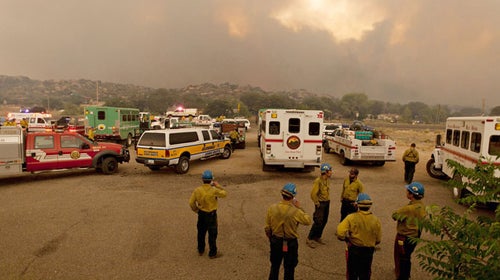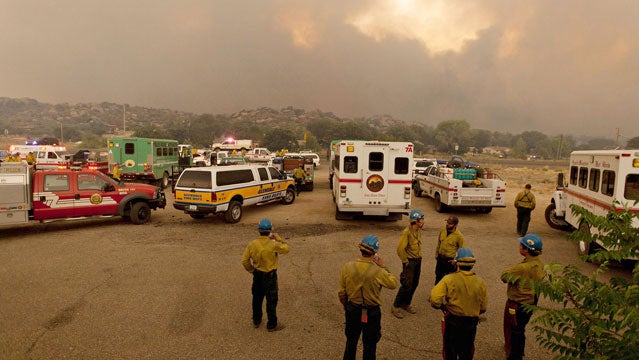Nothing changes the direction of a wildfire quicker than a thunderstorm, and that is most likely what happened this past Sunday afternoon. As the sharp line of storms moved down canyons toward Arizona’s then-800-acre Yarnell Hill Fire, the clouds produced no helpful rain but plenty of lightning, along with gusty, erratic winds. Unlike the prevailing breezes that blow across much of the desert Southwest in summer, thunderstorms create down drafts—mammoth, sustained exhales of cold air. When these 40- to 50-miles-per-hour winds hit the flames, the Yarnell Fire exploded. In moments, what was once a dangerous but relatively predictable fire was out of control. By Sunday evening, some 2,500 acres were blackened, more than 250 houses and outbuildings burned, and 19 members of Prescott’s Granite Mountain Hotshots lay dead on the line.
Portraits of the Granite Mountain Hotshots
Photographer Jakob Schiller captured the crew as they fought a wildfire in New Mexico.In the Line of Wildfire
A close look at an elite group of wilderness first responders.This is the worst wildland firefighting tragedy in nearly 100 years. The most analogous incidents took place years ago, including the death of 13 smokejumpers on Montana’s Mann Gulch fire in 1949 (the subject of Norman Maclean’s 1993 classic ), and Colorado’s South Canyon Fire in 1994, when 14 smokejumpers and hotshots died. The details of what happened this past Sunday are still emerging, but for me, too many questions surround the event.
The Yarnell Hill fire started on Friday afternoon, when a lightning bolt ignited a thicket of chaparral about a mile and half from the 650-person town of Yarnell. Because the fire threatened buildings and infrastructure—thanks in part to chronic drought that had left the chaparral thickets tinderbox-dry—the fire was quickly made a national priority. Approximately 200 firefighters from around the country converged on the town, while a larger, more experienced incident management team was brought in to replace the local unit running the initial operation. As with any job where power is transferred from one group to another, there are always kinks in communications, logistics, operations. Wildfire fatalities have often corresponded with this transition period, when lapses in communication can have deadly consequences.
How much the change in fire leadership had to do with the firefighter deaths is yet to be known. So is how the presence of houses affected the hotshots’ decision-making on the ground. In wildland firefighting, as with all firefighting, there’s nothing more important than protecting homes from destruction, but in the past decade, more than 20 million people have moved into the lands that will eventually be threatened by wildfire. Was Granite Mountain’s supervisor, the field general in charge of making calls on the ground, more willing to expose his crew to risk because houses were at stake? Did they lack information, unaware of the line of thunderstorms approaching from the northeast?
Early reports suggest the Granite Mountain Hotshots were building a “direct line”—a fuel break that chases the fire’s jagged edge—along the eastern flank when the winds hit, changing the direction the fire burned and increasing the rate at which it spread. In the dry chaparral, the storm’s sudden winds would have created a dire situation, the flames advancing faster than the team could escape. Even still, the last thing any firefighter wants to consider is deploying their shelters, aluminum pup tents that reflect heat. When it’s absolutely clear that they cannot outrun the flames, and the firefighters are left with no other options, they look for a small clearing, scrape away anything flammable, dive under these Hail Mary tents, and pray. All 19 of the Granite Mountain Hotshots deployed their shelters.
It’s hard to overstate just how horrific the next moments must have been. Inside the small shelters temperatures can quickly climb above 200 degrees; outside, winds can blow in excess of 60 miles per hour, spiking temperatures above 1,000 degrees. Survivors of such burnovers describe the experience in the bleakest of terms: there are moments when removing the shelter and surrendering to the flames seems preferable to being slow-cooked inside. Some of the bodies of the Granite Mountain Hotshots were found outside their shelters. Did these firefighters shuck the shelters off their backs, a phenomenon documented in previous wildland fires? Or were the winds so strong the shelters were torn from their hands?
It may never be known. What is known is that that fire shelters aren’t designed to withstand direct flames. If the fire burns too close, the shelter’s aluminum exterior is singed, the glue that keeps the heat shield intact melts, and the shelters crumble. Deploying the tents is a last-ditch attempt at survival. We learn early in our training that relying on them may mean it’s too late.
Every trained wildland firefighter is forced to consider these scenarios during training, but the threat always feels distant. In the wake of tragedies like Yarnell Hill, it’s easy to understand why the wildland firefighting community’s reaction is so swift: we all understand the risks. Just hours after the announcement, a Facebook page, In Memory of the Granite Mountain Hotshots, had 56,000 likes. It now has more than a quarter million.
Over the coming weeks, pundits and firefighters alike will speculate about what these deaths mean. From my perspective, it’s beyond tragic: It’s wasteful. As Norman Maclean put it: “Probably most catastrophes end this way without an ending, the dead not even knowing how they died… those who loved them forever questioning ‘this unnecessary death,’ and the rest of us tiring of this inconsolable catastrophe and turning to the next one.”
To me, these firefighters are heroes, and not just because they are colleagues: They are public servants dedicated to doing what they believe is right, willing to defend our communities at their own peril. But I simply cannot reconcile the loss of these 19 young men to save something as ephemeral as a house. I pray that we never see such a tragic waste again. But unless something changes in the way that we deal with wildland fires, until history becomes our teacher, I fully expect we will.


